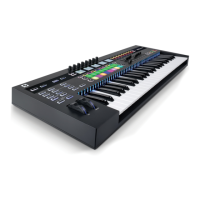16
Arp Part
Arp can only arpeggiate one Part at once, so by default, this
is set to ‘Selected Part’. However, using the soft buttons
below the screens, you can send the arpeggiated pattern
to parts one through eight instead. In other words, you can
send your arpeggiated patterns to different Parts to audition
them on various elements of your song.
Arp Type
You can set Arp to the following pattern ‘Types’:
• Up (default) - Notes held or latched (with the Latch
button) play in an upwards direction at the Arp Sync
Rate, one after another, then the pattern repeated.
• Down - Notes held or latched play in a downwards
direction at the Arp Sync Rate, one after another, then
the pattern repeated.
• Up/Down 1 - Notes held or latched play in an
upwards direction, then downwards direction with no
repeated notes, at the Arp Sync Rate, then the whole
pattern repeated.
• Up/Down 2 - Notes held or latched play in an
upwards direction, then downwards direction with
the highest and lowest notes repeated, at the Arp
Sync Rate, then the whole pattern repeated.
• Random - Notes held or latched play in a random
order at the Arp Sync Rate until keys are released.
• Played - Notes held or latched output in the order
they were played, at the Arp Sync Rate, then the
whole pattern repeated.
• Chord - Notes held or latched play as a chord on
each Arp step, at the Arp Sync Rate, until the notes
are released.
Arp Gate
The Arp’s Gate control shortens the length of arpeggiated
notes from the maximum length of one arpeggiated step
(100%) down to 1/100th of an arpeggiated step (1%). Gate
is set to 100% by default, with an adjustable range of one to
100%. Gate considers Arp Sync Rate and tempo; therefore,
as Sync Rate changes and tempo increases/decreases the
Arp gate length will remain a consistent percentage of the
Arp step length.
Arp Sync Rate
This changes the musical rate the Arp runs relative to the SL
MkIII’s clock. The Arp can be set to these sync rates:
• 1
• 1/2
• 1/2 Triplet
• 1/4
• 1/4 Triplet
• 1/8
• 1/8 Triplet
• 1/16 (Default)
• 1/16 Triplet
• 1/32
• 1/32 Triplet
Arp Octaves
This setting increases the output range of the Arp by octaves.
For example, if you set Octaves to two the sequence plays
and then Is immediately repeated one octave higher. Three
means the Sequence will repeat one octave higher, and then
an octave higher still. By default, Octaves is set to one but
can go as far as six.
If arpeggiated notes go out of range, the Arp will correct the
notes to within the top octave (G#6 to G7). There are no
duplicated notes when you change Arp Octaves.
Octaves interact with Types in different ways. These
scenarios are a reference when programming with octaves
in mind:
• When Type = Up/Down 1 or Up/Down 2 the Arp will
play up the full octave range before playing down.
• When Type = Played the notes play in the first octave
before repeating in additional octaves.
• When Type = Random, the sequence of notes is
randomised across the whole octave range, and
every note is picked at random.
• When Type = Chord, additional octaves will cause the
held notes to repeat according to the octave setting
in an upwards direction. For example, if Octaves =
3, the held notes will be played as a chord at the
pitch, then +1 octave and then +2 octaves, before
the pattern repeats.

